Tornado warning
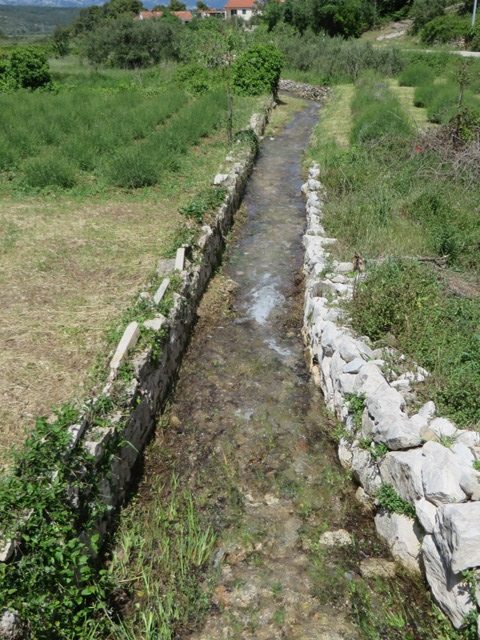
This week: Rain; Cut-off Low; Tornado warning; Station stats; Cats teeth; Soil science; Bird song;
Regular readers know I keep a sharp eye on the weather, so I had seen on the forecast that we were going to have some more rain this week. But it really started with a bit of a bang.
I was outside when the rain started on Sunday morning. It quickly became heavy, then torrential and there were a couple of thunder claps and the power went off for a few seconds. The rain continued all day. I kept watching the rain gauge on my weather station as it registered 25mm (1 Inch), then 50mm and upwards in a fairly steady progression.
Looking out of the study window, there was a fine spray coming off the roof of my neighbours opposite, having the appearance of a halo because the water droplets were falling with such force that they were atomising as they hit the tiles.

The hillside opposite, less than a half kilometre away was almost hidden by a veil of rain and the felines had retreated into their bed. Neither likes rain or thunder very much.
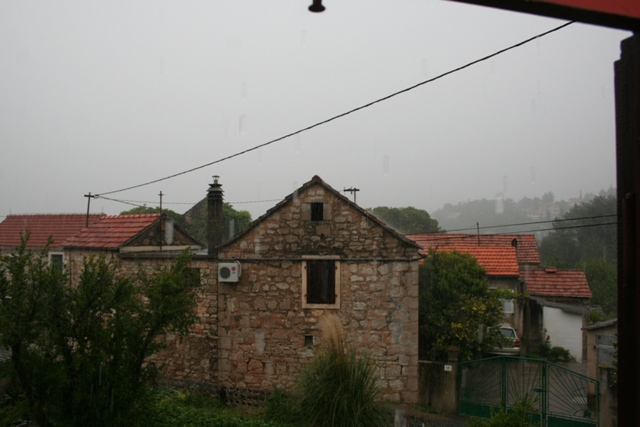
The Stari Grad plain was invisible, as was everything beyond.
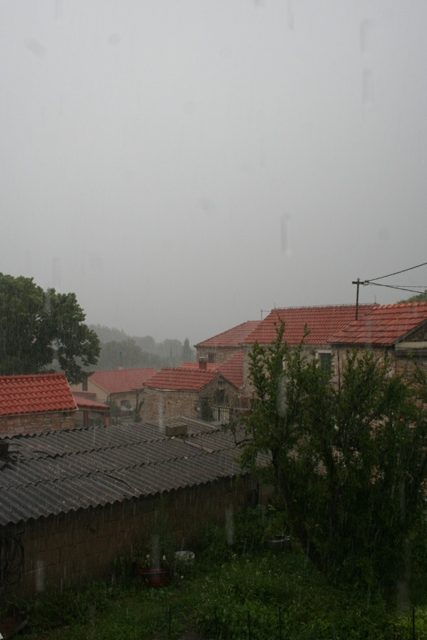
It was a day for doing more photo scanning, but during the occasional lulls I kept checking that my various rain water recovery pipes were all working. They were. By nightfall the rainfall total was over 90mm.
When you read or hear a weather forecast and the Meteorologist mentions so many millimetres of rain, it is difficult to visualise what that actually looks like. The international measurement of rainfall is in millimetres, except in the USA who use inches. But what I like about this part of Europe is that they talk about litres per square meter.
You can visualise a square metre (or square yard), now think of a litre bottle of milk, juice or fizzy drink, or may be a half litre, 50cl of beer. If one millimetre of rain has fallen, that is one litre of water to every square metre. 25mm, or one inch, is 25 litres of water to the square metre. You can see where I am going with this. I just cannot visualise 25mm, but I can imagine 25 bottles of water. It’s a lot.
So on Monday morning, when I looked at the weather station data and it had recorded 110mm, or 4½”, that is a goodly quantity of rainfall. It has certainly filled up my water cisterns nicely.
Cut-off Low
The cause of the deluge is what is know as a “Cut-of Low”. This is a swirling anticyclone – an area of low pressure rotating anti clockwise, that is in the upper atmosphere and has become detached from the usual cyclonic weather systems.
Northern hemisphere weather moves in a general west to east path. Being cut off from the integrated weather, a cut-of low moves independently, can even move east to west, or can remain stationary and can deposit huge quantities of precipitation.
A cut-off low usually begins as a trough in the upper-air flow, which becomes a closed circulation and then extends down to the surface. Also known as closed low or cold pool. A cut-off low is marked by more or less concentric isotherms around the core of the low.

Once again, this is not a normal weather situation for the Mediterranean, at any time of the year, let alone in early summer. As a friend commeneted on last week’s blog, this time last year we were almost in a drought, the beaches were full and the sea was warm. Not this year!
Tornado Warning
My weather station recorded the highest amount of rainfall in western Croatia on Sunday and it even rated a mention in the Slobodna Dalmacija newspaper. This made me suspicious. I checked the location of the receiver. Was it taking spray from a roof, like the house opposite? No, the wind was coming the other way. A look at the graph for the day shows some pulses of heavy rain, but it is generally a progressive increase.
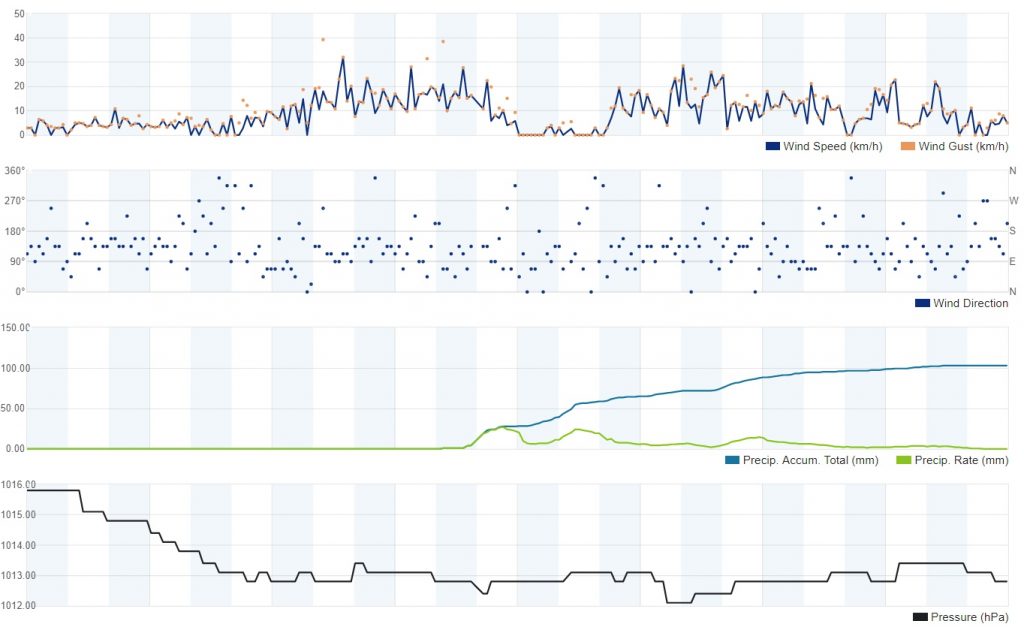
It is measuring properly, so I’m happy that it is accurate. It may well be that the location of my home and the surrounding hills have influenced the rainfall, but we did have a lot!

I subscribe to the European Extreme Weather Centre and they sent out a warning on Monday morning, of the potential for Tornado’s in this part of the Adriatic. We are not exactly in tornado country, so I passed on the warning via FaceBook.
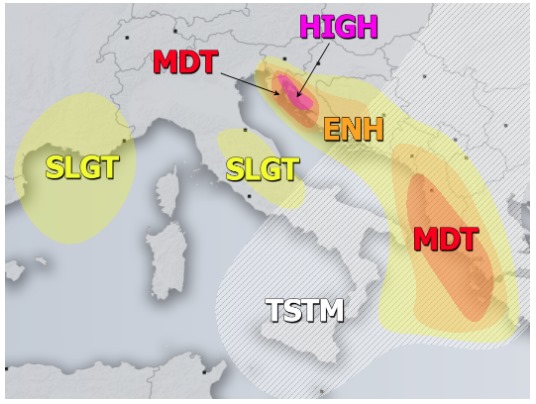
There is a network of storm prediction centres, which have standardised their terminology, so MDT / ENH means ‘moderate / enhanced’ risk, where ever in the world you are.
Station Stats
Although the spring close to the lane up to my Dol house had started flowing on Tuesday, it was not sufficient to wash down the gully by the side of the lane and over the road. However in the other half of the village, by Wednesday when we had returned to normal sunshine, the stream was in full spate. I have noticed before that after even moderate rainfall, the stream in Dol Sv. Maria is always flowing.

Here in Dol Sv. Ana our stream has had water in it just once since I have been here, and I was told that that event was the first time in 40 years that there had been flowing water.
The almost total lack of sunshine has meant that I have been up on the roof to uncover tubes on the solar water heater. In March I had covered ⅔ of the tubes, as I must do every year to stop the water boiling and the safety valve lifting. This week I have removed one of the covers, so that just ⅓ of the tubes are covered. The ‘hot’ water has been tepid for a week, not even approaching hot. But after taking the cover off, I soon had hot water again.
Not “hot” like it normally is, when at the taps I have to mix ⅔ cold to ⅓ hot for it to be bearable. No, running 100% hot water, the shower was just comfortable. Looking at the graph of the average maximum and minimum temperatures for the week, the 2019 lines clearly show how the temperature has been depressed.
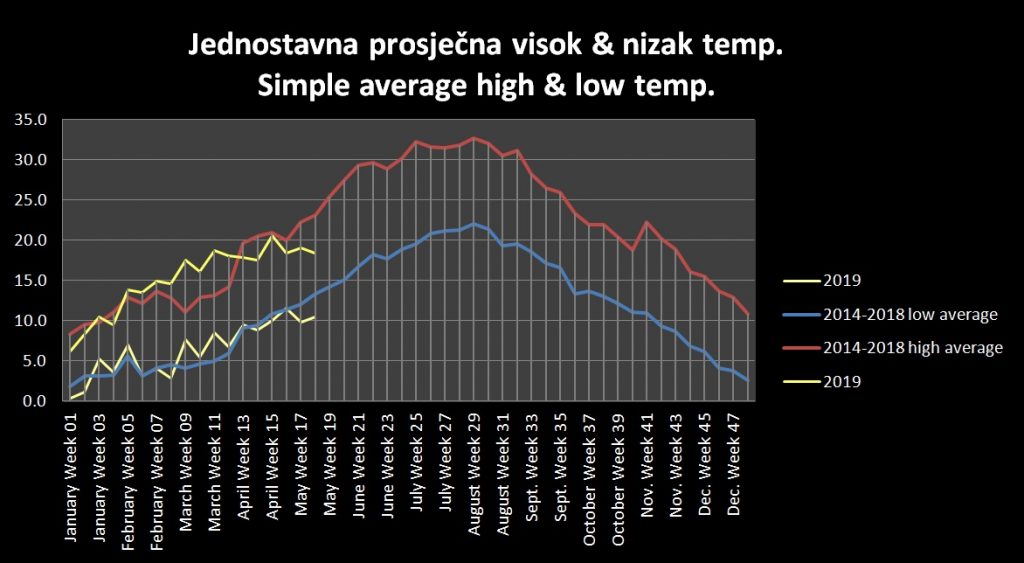
Cats teeth
Risha is much better. He’s back to his five a day. That’s not five fruit and vegetable portions, as per health guidelines, but five square meals along with mouse sized snacks whenever I have a cup of coffee. He’s back on the sea food diet – see food and eat it!
He had surgery on Wednesday, the vets x-rayed and cleaned his teeth and removed the root of the broken canine incisor, which had been giving him the toothache. All without complications.
The instruction was to give him soft food for three days. So I went back to basics. I have a lot of kitchen utensils, some electric and a few from my Grandmother, but it was one of these that I dug out of the cupboard.
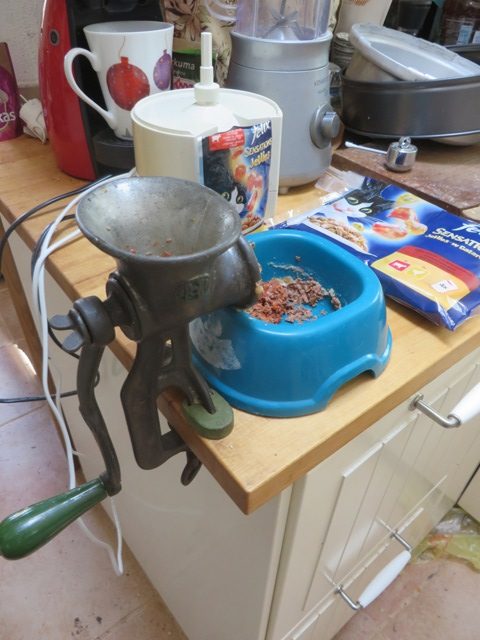
This is a classic household mincer, made by a company called Spong in the 1920’s, and still going strong.
Sometimes you just cannot better an old design, to the point that when I had a look on-line to try and accurately date the mincer, I found that several companies are making replicas, out of modern alloys and composites, rather than cast iron, now powder coated in different colours, but the design has not been improved on for a hand mincer.
Risha loves his Felix, especially the lamb flavour, so I minced several of the sachets ready for him. I also minced some tuna.
This is the only way I can get him to take the antibiotic he is on for a week. The tuna is the human food variety, rather than Felix, in water, so it makes a tasty paste. I grind up an antibiotic tablet, because I cannot get it in his mouth and persuade him to swallow it whole.
But in the tuna, it is gone in an instant. The vet said that there was no difference to the tablet’s effect, whether whole or crushed.
The next issue is keeping his teeth clean. He had a scale and polish while he was under the anaesthetic and I see on line that you can now buy toothbrushes and even toothpaste for felines. It does seem to be going to extremes a bit though! I think I’ll try and persuade him to eat more cat biscuits which have the same effect!
Soil science
I am doing the last module of the Future Learn/University of Dundee course in soil science at the moment and this week the subject of ‘No Dig gardening‘ was explored. No dig is an organic way to manage land, whether on a small or larger scale, making use of the existing food web of microbes to enhance soil.
A fellow student from Cyprus explained how they use an adaption of the method to control weeds and improve soil in their orchards, so I’ve had a go this week. Keeping on top of weeds is a bit like the spinning plates. In fact some of the thistles I have resemble the spinning plates!
The advice from Cyprus is that they don’t dig weeds out, rather they cut them down and allow them to rot between the trees and this both improves the soil and prevents new germination. They need to cut only twice a year.
Trying to keep the weeds down seems to be a permanent exercise for me so this week I’ve been cutting between the trees in the drupe orchard. I initially cut using shears – I didn’t want to get the petrol strimmer out – then I used my hand scythe once I had dug out the thistles. These are the only weeds I am digging out, because they have long tap roots and cutting the tops off just makes them grow more.
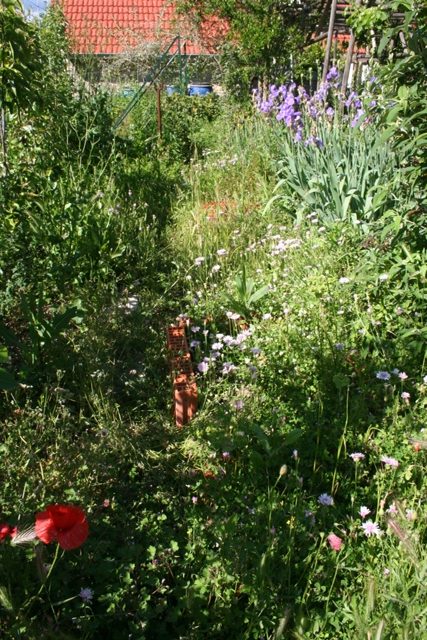
I’ll see what effect it has, against the other orchards where I’m trying different methods.
Bird Song
The bird song at the moment is superb. 24 hours a day the Nightingales are singing. I have a pair in the almond tree near the kitchen. Then there are the Golden Oriole during the day and the Scops owls at night and a myriad of calls I can’t identify. However early on a couple of mornings, I’ve heard Bee Eaters and twice I’ve seen them on the electric wires. Unfortunately each time the sun has been behind them.
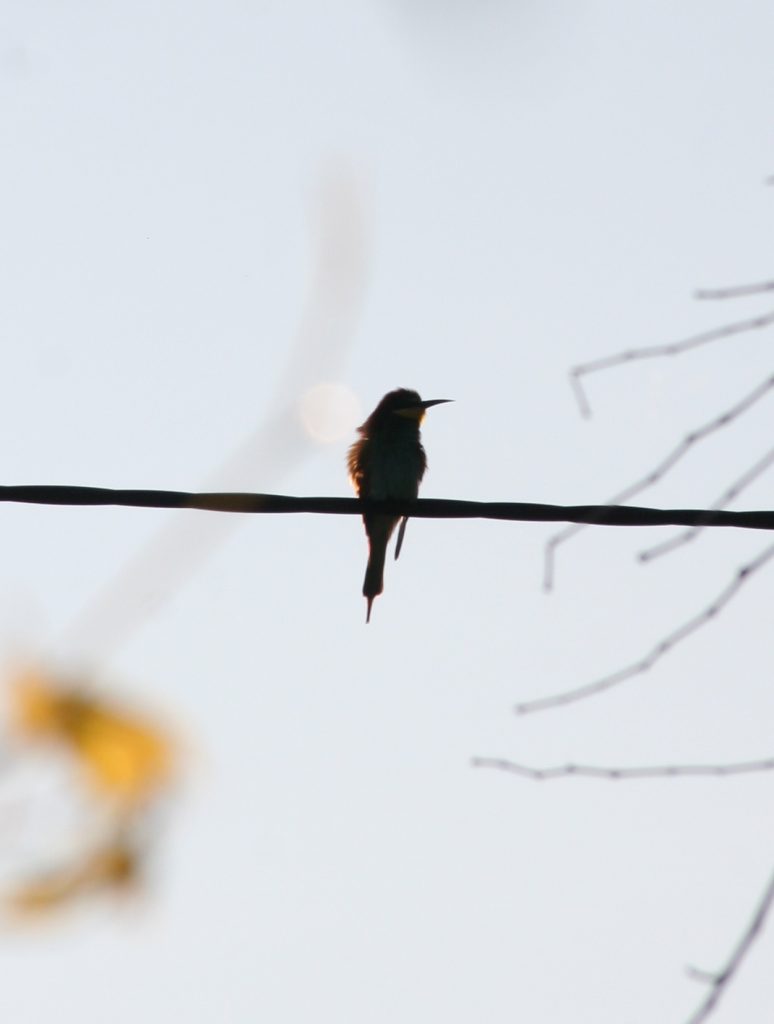
These are some of our most colourful visitors. Whilst watching a group of a dozen or so, I saw individuals dart off, grab a flying insect – not just bees – and then come back to the wires to feed.
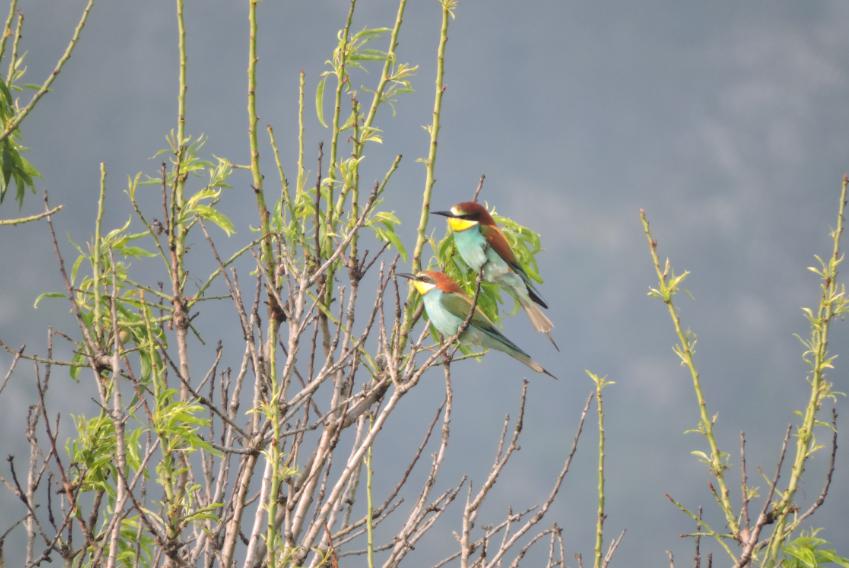
Like Sand Martins, they dig burrows in sandy banks and build their nests at the end of a tunnel. I know the location of a couple of nesting sites, but I have not seen them as close to home in previous years and wonder if they are nesting in a bank somewhere close by? NRC
6 Responses
Bob Denton
Lovely account Norman.
Hoping all is now back to near ‘normal’ and you have dried out.
Loved this account. You are at one with nature.
Best wishes. Bob
Andy Obridge
You will be having hot and cold showers for a while yet Norman, still unsettled as you know.
I see you are still measuring rainfall in mm. For a short time they were quoting litres per sq m but back to just mm it seems.
I have a stream nearby that is usually dry, I was confused as it was even after rain, but flowed during dry spells,then I found someone has a dam, forming a pool, further upstream. They just release it when they need to.
So I have been doing no dig Cyprus style and did not know it! I just strim around the trees. Used to be Spring and late Autumn before olive picking but will need to do before as the weeds are thriving with the rain!!
Talking of olives, despite the wind and rain they are still full of seeds. They were last year but a poor harvest. Cou can never know until November, picking time, how it will be.
Andy Robby
Fabulous as usual… But you spoil that cat…
John PANK
I am pleased you dodged the tornados.
Bill Hollis
You certainly had a wellington boot experience. Love the cat story, I wish our moggy would go on a diet—her’s too is a 5 a day.
Dorcey Wingo
Caviar isn’t hard to prepare, Norman. Have a heart!